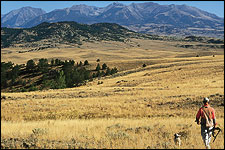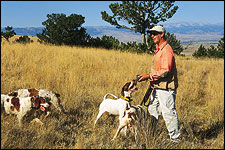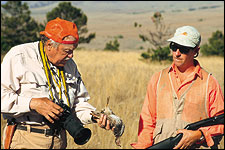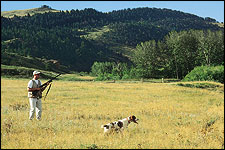Hunting Big Sky Huns requires strong legs and plenty of dog power.
 The Hun and sharptail country stretched as far as the eye could see. |
When you leave a hunting vehicle in Montana you walk up a hill, and when you return to the car, you still walk up a hill. I have come to the conclusion that in the Big Sky Country, water must flow uphill.
My son Sam and I made our annual bird-hunting trip to Montana early last September to catch the sharptail grouse before they bunched up in large numbers, posted sentinels and flushed wild. We were also hopeful of finding Hungarian partridge, which had not been plentiful during our previous two years in North Dakota. This was not planned as a guided hunt. We flew out to Montana on the cheapest available airline tickets, rented a four--wheel-drive carryall in Billings, and then headed north, not knowing where we were going, but looking for some good prairie-bird habitat and hoping to see some birds along the roadside.
We traveled about 150 miles into the north-central part of the state and stopped at a small cafe where the owners told us of a good number of sharptails and Huns about a mile out of town on some land which the state of Montana had leased from local farmers for public hunting rights. This sounded good to us, so we checked into a modest but adequate, six-unit motel, and by 3 o'clock had unloaded our Brittany, Jock, and were hunting. We were just six hours from Newark International Airport in New Jersey.
Other years we had driven out west in our motor home, towing a small four-wheel-drive utility vehicle. The trip had always been a three-day haul to get to the Dakotas and then three-days to return home. Six days of driving shot a big hole in our two weeks of vacation time.
Sam and I followed the directions given to us by the cafe owner and found the first of a number of state "Block Management Areas" where the landowner receives a small chunk of money for leaving his land open to public hunting, providing the hunters check in and check out. This three-million-dollar program has helped landowners and provided hunting opportunity to the tune of 350,000 hunter days in 1998.
 Ben Williams' pointer, with a sharptail, was enough to make a man leave home. |
There was a road cut through a couple of forbidding looking hills and coulees, and a small stream in a heavily vegetated flood plane about a mile wide. It wasn't what I would call good sharptail or Hun habitat, but we decided to give it a try, if for nothing more than to run the dog.
We crossed the field, and Jock pointed. As we walked in, a covey of about a dozen Huns knocked the buttons off our vests. Sam dropped a bird, and I put a load of 8 shot right between two other birds. Sam said something to the effect that we hadn't traveled 1,700 miles to miss birds. I promised not to miss any more. But I lied.
By the time the sun was setting we had flushed three more coveys and were like two kids in a candy store. We didn't see a sharptail, but I honestly prefer Huns, as they tend to lay tighter to a pointing dog--much like the quail we used to have in the East.
On the way back to the motel we saw a well-kept small farmhouse where a woman was hanging out clothes. I stopped and asked her if she would like to have some partridge. Her eyes widened, and she said, "I'll take all the partridge you care to give me. We love them." We unloaded all seven of our birds, and she invited us back the next day to hunt birds on their 4,000-acre ranch. This turned out to be one of the better deals of my life.
Our small motel had a nice restaurant nearby where a steak dinner, salad bar and dessert amounted to $8 a head, with no waiting line. The motel room cost us $30. To say life is simpler, friendlier and less expensive in Montana, compared with New Jersey, is the understatement of the year.
For three days we hunted on the Block Management Areas, which required only filling out a hunter-use card for where we would be hunting, what game was taken and when we finished hunting. No charges or problems. We never saw another bird hunter in our entire week of hunting in Montana, but an occasional elk hunter passed us on the road.
 Sam takes a bird from one of Ben's dogs. Williams hunts six or eight dogs at a time. |
On the second and third days of hunting we proceeded on down the little valley following the stream. We counted about five coveys and hunted for five hours. The dog worked reasonably close with only a few "attention getters" from his training collar. His recent force breaking to retrieve to hand was always remembered. The weather was a little warm at midday, which made for a relaxing lunch break. We never hunted the same ground or shot at a covey more than once. This Hun hunting was among the best I have ever experienced.
By the end of the third day, Jock began to slow down and walked like he had stones in his shoes. I noted a little blood in his dog crate, and when I examined his pads, they were a bloody, swollen mass. I had not noticed any vegetation heavy enough to cause this problem, but something had torn up his feet, and he was through hunting.
I admit that I should have hardened up his feet a few weeks before our trip, and then inspected them daily for abrasions, and also should have used dog boots. We tried him with dog boots after seeing his condition, but his feet must have been too sore to put on the ground. There was a veterinarian in the small town where we stayed, and he advised us to lay the dog up until the pads healed, and gave us some salve and Jock a shot of antibiotics.
All was not lost. That evening I called my friend Ben Williams in Livingston and reported on the excellent hunting and the status of our dog. Ben knows a great deal about bird hunting in Montana and most of the rest of the United States. He's an outdoor writer and photographer whose pictures make you wish you were right there. He said he had a few days free on which he planned to hunt on some 40,000 acres of land, and we should drive over and help him. Ben and his charming wife Bobbi have a beautiful ranch-style home on several acres of land looking directly at the Sleeping Giant Mountains through a large one-way glass picture window. The kennels are a short distance from the house and
shelter 22 Brittanies and one young English pointer who thinks he's a Brittany. We arrived at Ben's and medicated our dog's feet, which were still so sore he had trouble walking. Ben said let him rest and we would take his dogs. When he said dogs, I was thinking of a couple or possibly three.
 Ben shows Sam a Big Sky Hun. |
The following morning Ben backed his pickup truck out of the garage and opened the doors to all 10 of its dog compartments. Suddenly, from the kennel came a great flush of Brittanies and a pointer arriving in a hairy avalanche. I counted a dozen dogs going by, but missed a few. Then the amazing happened. Ben took a plank about eight feet long from the roof of the truck to make a ramp from the ground to the dog compartments. Then he methodically moved the ramp and loaded each dog by sending him running up the ramp and into his own compartment. The entire operation only a few minutes. We drove a few miles out of town and into a giant ranch and farm of 40,000 acres complete with snow-capped mountain and many mini-mountains, which he called "hills." As we drove, Ben pointed out, "There was a covey over there. Last week we saw two coveys here." Within half an hour we were deluged with covey reports. "Okay, Mr. Williams, show us some of these Huns in the feather," I said. He pulled to an abrupt stop, stomped on the emergency brake to keep the truck from running away and began letting dogs loose. I had never hunted over a pack of 12 pointing dogs, but after I got over my shock at the length of this landscape, I realized there was room for everyone.
This was vastly different country than what we had hunted in the north-central part of the state. There was excellent bird cover, and Ben's army of dogs spread out and appeared to cover 10 acres of countryside in a combined cast. When a dog pointed, the dog which saw the point then backed. To me this was the high point of the trip. The trick now was to get to the pointing dogs as quietly and quickly as possible, and then follow Ben's instructions as to exactly where to stand when he flushed the birds. From past experience, he knew what each covey would do. He was right most of the time. Being a New Jersey flatlander who lives on Barnegat Bay where the elevation is about five feet, the 4,500-foot altitude was a physiological shock to my respiratory system. To further complicate things, somehow I had reached 73 years of age, which made me something less than a spring chicken. Then, to add insult to misery, my son, who is in his 30s and in top physical condition, and Ben Williams, an ex-wrestler who hunts more than 200 days a year, tended to leave me huffing and puffing a dozen yards behind them as they climbed the so-called hills.
Did we find birds? It seemed like the Huns ran out of the cover, threw their wings in the air and said, "We quit." But not quite. I would estimate that the dogs found and pointed about three coveys per hour. However, these were hard-earned birds, more difficult than the wild bobwhites we enjoyed before the quail depression on the east coast.
Once in a while Huns or sharptails would fly into a distant coulee where the brush was thick and they were simply absorbed into this vast greenery. Following these birds into a coulee with 40-degree sides, stumbling over rocks the size of your head, looking out for an occasional rattlesnake, and at times crawling on all fours in a particularly rough spot was a feat to be included in the next Olympics.
My outstanding memory of this event was a sharptail flushed by Sam that came boring directly at me about 30 yards overhead. I let him pass, stepped back to shoot and found the coulee had dropped a foot below where my size 10 boot should have been placed. I made a turn in the air, landed on my gun, broke the gun's forearm and then slid face down in the coulee. When I sat up, I looked like I had lost a duel, with cactus spines sprouting from all appendages. I stayed on the ground until Sam came up and asked, "Are you all right?" I said, "No, just call the doctor." He replied, "You had better get up or we will have to gut you to get you out of here." At that point I gathered up what was left of me and stumbled on like a member of the Bataan death march.
 Hunting the flood plain resulted in five coveys of Huns in four hours with excellent dog work. |
We hunted with Ben for three days, and he spent most of the time with his camera shooting pictures. He is probably the best bird hunting photographer in the business. Not because he has the best equipment, but because he spends hours and days shooting those wonderful action pictures you see in many of the outdoor publications.
At one point the fine young pointer, which I would have given my soul to own, pointed at the base of a small bush. Sam walked in, saw the bird and didn't know what it was. Ben said it was probably a spruce grouse, and he wanted a picture of me shooting at it. To make a long story short, the grouse came out of the brush, flew within 30 yards of me and I missed with both barrels. I used the excuse that I was too busy admiring the bird and didn't swing through it. Not a bad excuse, but no one believed me.
On the last day of the Williams' forced march, Ben brought out a little 20 gauge Browning over-under, which he loaded with three-inch 6s. I must report that Ben is as good a wingshot as he is a photographer. He picked his bird on the covey rise, dropped it with a single shot and that was that. On two coveys he took a single shot and downed a bird. I asked him if his second barrel was broken, and he just smiled.
Hunting with my friend Ben Williams and my son was one of those hunts you remember, for the birds you killed, and the ones that got away, for your dog's behavior and misbehavior, and for the hunting conditions. But it was also memorable for the sheer enjoyment of being there with good friends and doing it. This is what the anti-hunting people can never comprehend.
Aside from being a great photographer and writer, he and his wife Bobbi are wonderful hosts and superb cooks. I would say that both are as good with frying pans as Ben is with a camera. The suppers we enjoyed and the lies we told may never be equaled. All agreed on one thing--bird hunting in Montana is superb, even though it is often an uphill battle.






